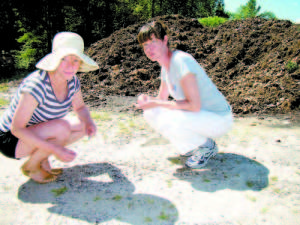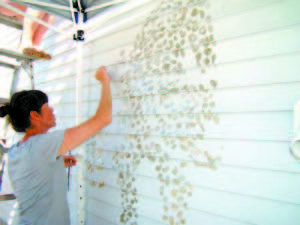Art is sifted, beauty revealed at Denmark’s town dump
Â

LOOKING WITHIN — Pink Pony Express artists Cecilia Hendrickx and Tara Karpinski spent three weeks in an art residency at the Denmark Transfer Station, and found their inspiration in the mica under their feet, and glittering within the solid waste mounds (behind). (Geraghty Photo)
‘The purpose of art is washing the dust of daily life off our souls.’
— Pablo Picasso
By Gail Geraghty
Staff Writer
A small-town dump in Western Maine is the last place you'd expect to find artwork. But to Jamie Hook, director of the Denmark Arts Center, there’s no more perfect place.
Inspired by the notion that Denmark’s Transfer Station on Hancock Pond Road is the major social gathering place in town (aside from the DAC, of course), Hook convinced the Dutch Embassy to pay flight expenses to bring over two artists from Amsterdam in The Netherlands who specialize in creating art in public spaces — akin (on a more modest scale) to the famed Christo, who wraps pink plastic around islands to make a point.
“I’ve always believed that art should surprise you, and bite you — that when you look upon it, you’re not in control,†said Hook. What might result if professional artists were given free reign to create a public art installation on site, using only materials found in the dump?
Buoyed by a $5,000 grant from the Oxford County Fund of the Maine Community Foundation, and Donna and Martin Seim’s offer of their lakeside cottage for a place to stay, Hook had all the pieces in place to bring over Tara Karpinski and Cecilia Hendrickx, from the artists’ collective Pink Pony Express. The PPE, formed in 2009, were intrigued by Hook’s call to keep in mind that the dump is a place all of Denmark’s 934 residents must go to get rid of their trash, and to create an image that reflects the public space as “a petri dish for the study of small-town life in America, in this, our third century.â€
One challenge remained, and it was a doozy. Hook had to convince Denmark’s Board of Selectmen to go along with the three-week residency. No one, not the artists, Hook, or the town, knew beforehand what the finished product would be, or what materials would be used to create it. But with the outside wall of the hopper building offering a big blank canvas, the possibilities seemed endless.

Artist Tara Karpinski applies a thin sliver of mica to the public art installation on the side of the Denmark Transfer Station’s hopper building. Can you tell what it is? Come to the opening on Thursday, Aug. 15, at 5 p.m. to find out. (Geraghty Photo)
“It was a risk for the town selectmen,†Hook acknowledged, saying the board had a hard time wrapping their minds around the project. “They thought that the dump was not a good place for art.†The board also had concerns over liability issues, envisioning a return to dump picking at its messiest.
The selectmen were won over, however, by support and assurances from Transfer Station Manager Don Legere and Ken Richardson, Public Works Director, that all issues of oversight and problem solving could be managed.
Karpinski and Hendrickx see themselves as visual journalists, who use images instead of words to communicate, said Karpinski, whose mother lives in Denmark.
Well into completion of the project on Monday, the artists said that it wasn’t long into their exploration of the dump that their eyes were drawn to the glittering display of pieces of mica on the ground. Tiny sparkles in the sunlight, the material was everywhere in sight on the road and in the mounds. As artists whose major aim through their art is to evoke interaction with the community, the women saw unspoiled silver flakes of silicate intermingled with waste, so ubiquitous, yet so ignored.
They knew they’d found their material.
Black tie optional
On Thursday, Aug. 15, at 5 p.m., the image they created from the mica and glued to the hopper building will be revealed to Denmark residents and friends at a champagne-toasting unveiling Hook jokingly calls “a black-tie optional affair.†They want the image’s identity to be a surprise, so no hints here — other than to say they found what they needed on the website of T.J.Max clothing.
“The nature of the material informs what it is,†said Karpinski. Knowing how essential Legere’s support had been to the project, they made sure he saw a photo of the image before they went ahead. “We didn’t want to offend him,†said Karpinski.
With help from Ivy Girdwood, a young resident of town, the women used window screens to collect mica all around the dump grounds, using the window screens to sift it from the dirt. They spent many more hours cleaning and splitting the silicate plates, to enhance the translucency and render the pieces more pliable. They had to travel to Portland to buy a special wheat glue that would stand up to high humidity.
Using a projector at nighttime, they traced the image in pencil on the side of the building. Then they spent nearly a full week filling it in by glueing literally thousands of overlapping mica pieces, giving a glittering jeweled effect.
The result is the first piece of public art in the town of Denmark, and Hook hopes it won’t be the last. Hendrickx said many residents who came to the dump over the weekend took pause from their automatic weekly chore to approach them and ask questions.
“Everyone’s been really positive,†said Karpinski. Even those who don’t know the first thing about art can readily appreciate, and respect, the amount of work that went into the project, she added.
“We hope that it becomes a kind of myth,†she said, “with people telling their friends, to say, ‘Did you see what they did at the dump?’ Our best hope is that a large part of this project will happen after we leave.â€
Hook, with characteristic energy and enthusiasm, has loftier ambitions, he said. “What you see is only part of the project. “We want the dump to be a destination, contributing to cultural tourism in the state of Maine.â€

